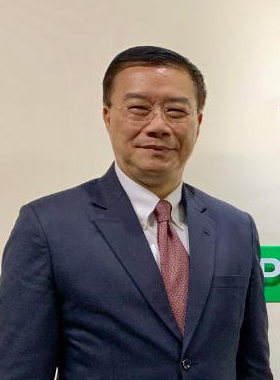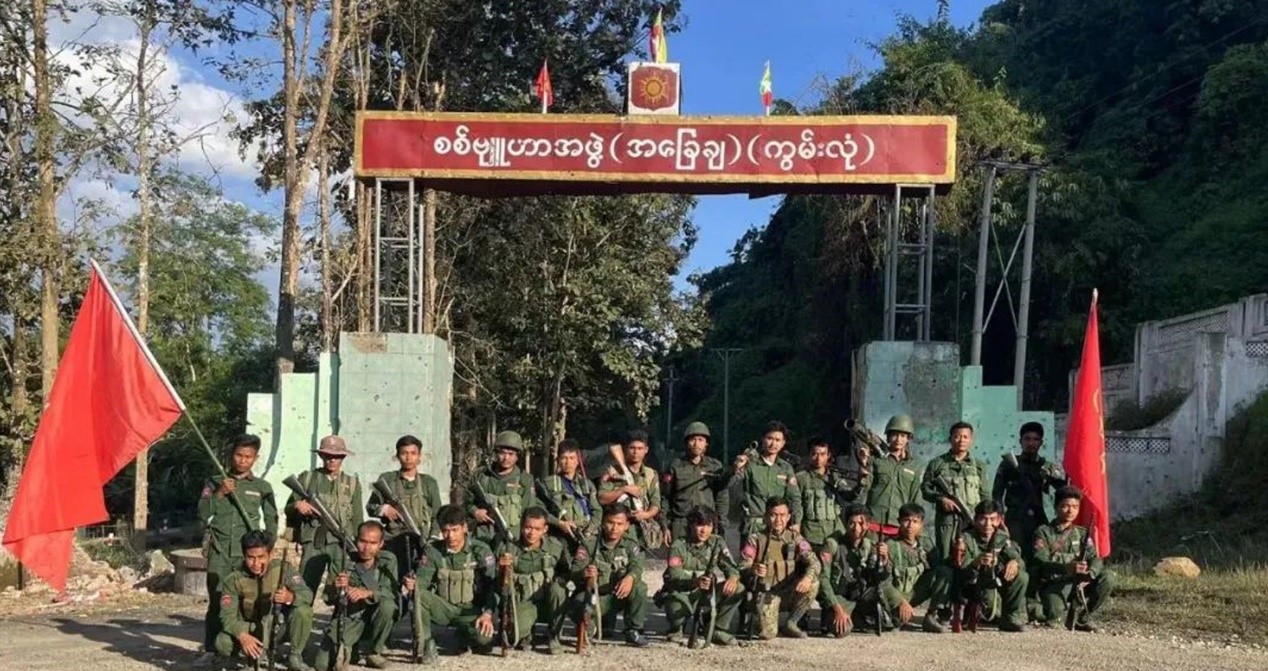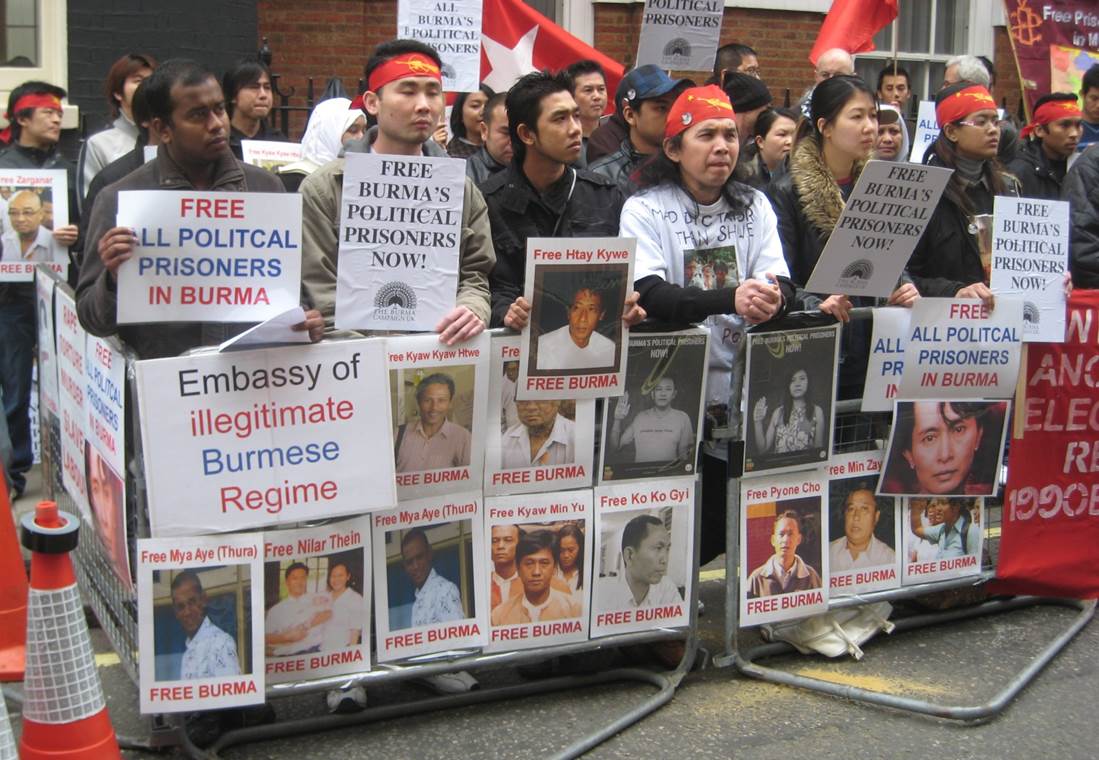The recent military offensive in northern Shan State, known as Operation 1027, orchestrated by the Brotherhood Alliance, has significantly altered the geopolitical landscape in the region. In the photo is Brotherhood Alliance members after seizing Kunlong on November 12, 2023. Photo source: Ye Myo Hein, December 2, 2023, Irrawaddy, https://www.irrawaddy.com/opinion/guest-column/charting-the-shifting-power-balance-on-myanmars-battlefields.html.
Prospects & Perspectives No. 67
Understanding Today’s Myanmar:
A Taiwanese Perspective
By Charles C. Li
The junta regime in Myanmar announced on July 31 the fourth extension of the state of emergency it declared when the Tatmadaw seized power from the elected National League for Democracy (NLD) government on February 1, 2021. The decision was a straight admission that the army cannot exercise effective control to stage polls and has failed to subdue widespread opposition — including nonviolent protests, civil disobedience and armed resistance — to military rule. The regime’s confidence in holding an open and fair election has waned and international expectations for it have dwindled.
A complex, escalating crisis
The recent military offensive in northern Shan State, known as Operation 1027, orchestrated by the Brotherhood Alliance, comprising the Myanmar National Democratic Alliance Army (NMDAA), Ta’ang National Liberation Army (TNLA), and Arakan Army (AA), in the name of uprooting the online scam compounds in Kokang, has significantly altered the geopolitical landscape in the region. Initiated on October 27, 2023, this new offensive resulted in the loss of approximately 300 bases and over a dozen towns along key trade routes between Myanmar and China, thereby challenging the regime’s control and straining Myanmar’s relations with China because of the disruptions of some main trade routes since the end of October. In response, the Chinese People’s Liberation Amy (PLA) immediately conducted military drills on the border. Three PLA Navy ships also arrived at Tilawa port for “naval security exercises” with Myanmar at the end of November.
The strategic prowess of the Brotherhood Alliance was exemplified through the capture of numerous townships near Muse in mid-November. These victories fueled speculation about the Alliance's ambitions, particularly regarding the potential seizure of the 105th mile and Jin San Jiao gates. Furthermore, reports indicate that NMDAA troops have successfully encircled Laukkai, the capital of the Kokang Self-Administered Zone, indicating continued efforts to consolidate territorial control against the regime.
The most recent repercussions of the conflict are evident in the mass displacement of tens of thousands of residents from Kokang’s capital Laukkai, seeking refuge in locations such as Lashio and beyond. The internally displaced persons (IDPs) in many states share the same hardships and dilemma. The humanitarian crisis unfolding in the wake of the Brotherhood Alliance’s offensive underscores the urgency of addressing the immediate needs of the affected population and emphasizes the importance of international intervention, especially by neighboring India, Bangladesh, China and Thailand, to get ready for more influx of the displaced civilians from Myanmar and to alleviate their suffering before it is too late. Already at least 2 million of IDPs have been reported by a UN agency since the coup nearly three years ago, and as the fighting intensifies, the number is increasing day by day.
Myanmar on the brink
Following the Alliance's offensive, the People’s Defense Forces (PDF) and other ethnic armies have intensified their attacks on Myanmar regime posts and bases in north Shan, Chin, Kachin, Kayah, Mon and Rakhine states and Magway, Sagaing and Mandalay, Yangon, Bago regions. These uncoordinated attacks by various factions indicates a broader resistance against the regime, highlighting the complex and dynamic nature of pro-democratic campaigns in Myanmar. The escalating conflict necessitates a nuanced understanding of the motivations and strategies employed by the Brotherhood Alliance and other resisting forces, including the EAO and PDF because there is no institutionalized command system among them. On the other side of the struggle, the Tatmadaw throughout the entire history of Myanmar since its independence in 1948, has not ever faced such multi-frontlines at the same time which have already caused thousands of defections, surrenders and casualties. The current situation in Myanmar is so perilous that the Acting President, Myint Swe, has warned that if the government does not effectively manage the incidents in the border region, Myanmar will be split into various parts. This is an understatement of the current political and economic situations at the end of 2023 and the prospect for Myanmar’s returning to the path of democracy is dim and pessimistic as it rolls into 2024.
On Myanmar’s domestic political front, Lt. Gen. Moe Myint Tun, who since the coup was a member of the State Administration Council (SAC) and held the positions of the Chairman of the Myanmar Investment Commussion, the Foreign Exchange Supervisory Committee, and the Central Committee for ensuring Smooth Flow of Trade and Goods, was sentenced to life imprisonment (equivalent to 20 years behind bars) in November 2023 for “abusing his position for personal benefit in violation of economic policies, and committing high treason by going against the roadmap and objectives” of the regime. He was removed from the above posts and forced to retire from military service. His Joint Secretary, Brigadier Gen. Yan Naung Soe, was also purged for committing similar crimes. Besides, the Deputy Commerce Minister, Nyunt Aung, was also detained for interrogation in response to soaring prices of basic commodities. The Deputy Prime minister and Minister of Home Affairs, Lt. Gen, Soe Htut, was forced to step down and transferred back to his original duties in October, 2023. He was then interrogated on suspicion of conspiring in corruption. Furthermore, the SAC has undergone five reshuffles since the coup, bringing the total number of its members to 18. All these purges and frequent changes reflect the corruption and instability within the regime’s most powerful governing body, at levels not seen in Myanmar’s previous military regimes.
Impact on Taiwan’s interests
How does the situation in Myanmar impact Taiwan’s national interest? How should Taiwan see Myanmar’s current situation? Firstly, the rocketing commodities prices, tight control over the supply of foreign currency, mainly the U.S. dollar, and the intolerable difference between market and official exchange rates (3880:2100) are not at all conducive to the robust and profitable operations of all foreign investors, especially for Taiwanese CMP businessmen. Although Myanmar is one of the 18 target countries included in Taiwan’s New Southbound Policy since 2016, with more than US$1 billion in FDI to Myanmar by Taiwan’s investors over the years, the government of Taiwan under the present circumstances should not encourage more tangible investments to Myanmar before the prospect for democracy becomes clearer.
Secondly, the EAOs and PDF’s territory gains in their more intensified and coordinated offensive will provide China a golden opportunity to launch a smear campaign against Taiwan by accusing the latter of involving in the drone attack near Myanmar-China border and providing assistance to some of the EAOs and PDFs against the general belief that China has been equipping and training them for a long time. China has spread rumors that Taiwan had worked with the CIA to support the EAOs right after the coup. Taiwan should be extremely cautious and take preventive measures to enhance PR campaigns in Myanmar and make necessary and timely clarification of Taiwan’s foreign policy toward the country. Thirdly, Taiwan should reiterate its concern for the Burmese people’s welfare and staunchly support Myanmar’s resumption of democracy as soon as possible, with an aim of encouraging more substantial investment in Myanmar to attain a win-win situation for both countries.
The Brotherhood Alliance’s Operation 1027 has reversed the geopolitical dynamics of northern Myanmar, resulting in significant territorial gains and strategic victories in favor of the resistance forces. However, the unclaimed responsibility for the drone attack at Jin San Jiao gate opens a window of opportunity for China to use misinformation against Taiwan. The humanitarian implications and the subsequent escalation of hostilities underscore the need for a comprehensive and strategic approach to address the multifaceted challenges posed by the ongoing conflict in the region. The coup has reversed more than 10 years of progress toward democracy after half a century of military rule in Myanmar. At present, very few observers expect that the Tatmadaw will regain control over all the posts and towns now occupied by the EAO and PDF, and more essentially, to subdue the widespread opposition campaigns in nearly all the states and some parts of the regions. Whether more EAO and PDF elements under the NUG will join forces to confront the Tatmadaw in the foreseeable future is the key to rebuilding a democratic Myanmar. Essentially, they have to strategize and transform their effort from sporadic offensives to a systemic military command and unite all factions to follow the detailed plan to distract the Tatmadaw’s comparative well-trained and better-equipped forces. Otherwise Myanmar’s path back to democracy may take many more years and the people living in Myanmar, or those who have been displaced from their homes, are doomed to suffer much longer.
(Dr. Li was Taiwan’s Representative to Myanmar from Jan. 2020 to Feb. 2023. He is currently the Secretary General of Taiwan’s International Cooperation and Development Fund.)



